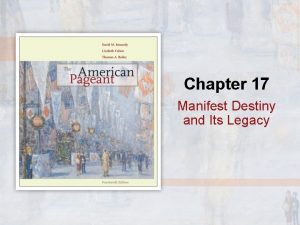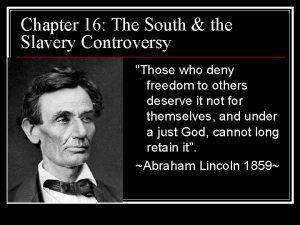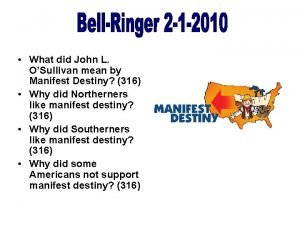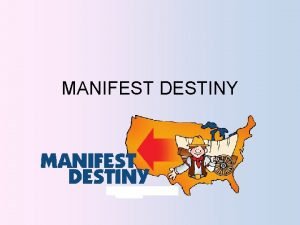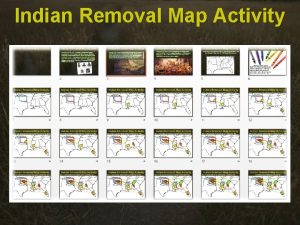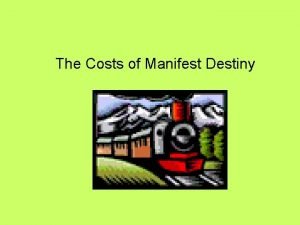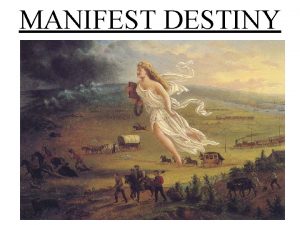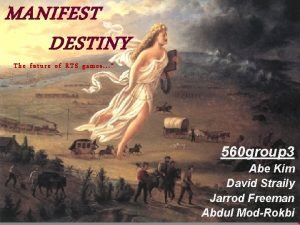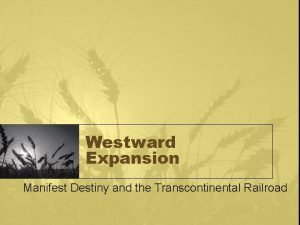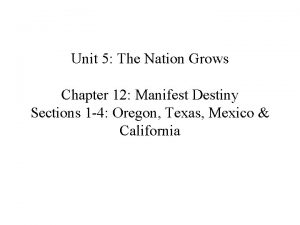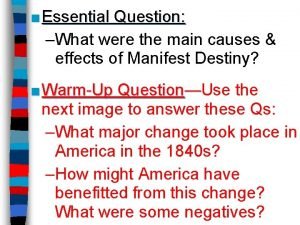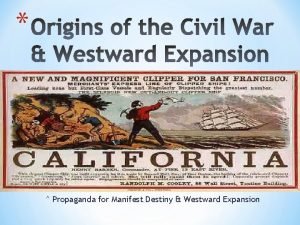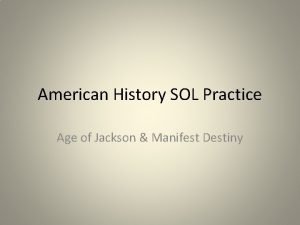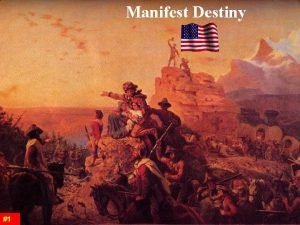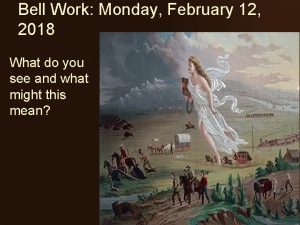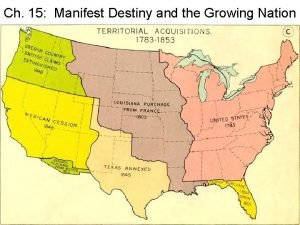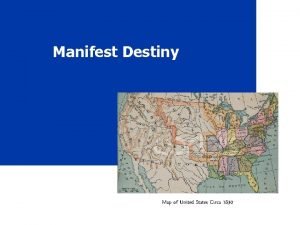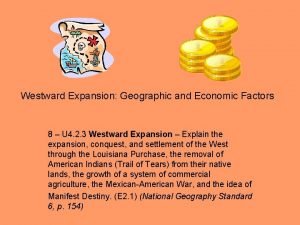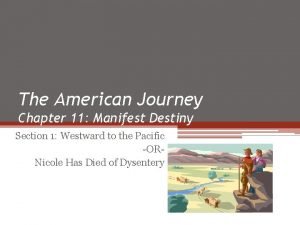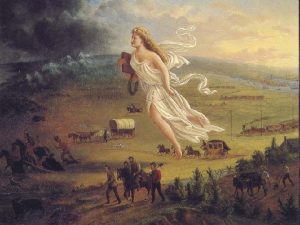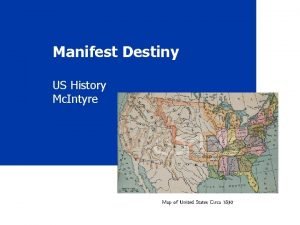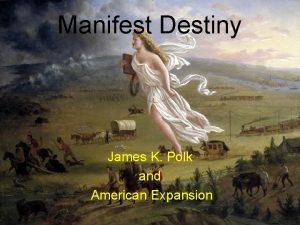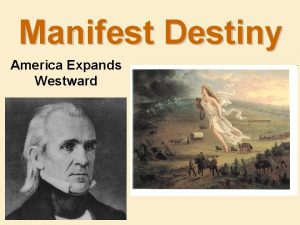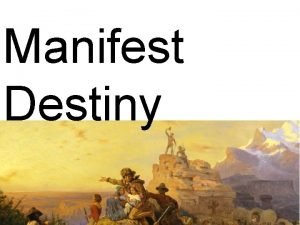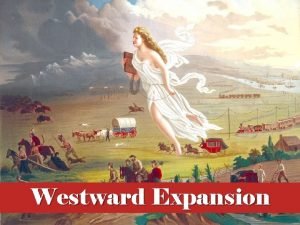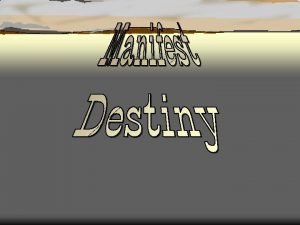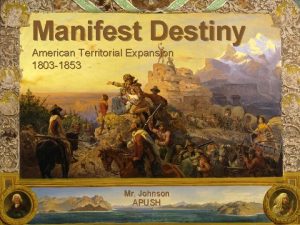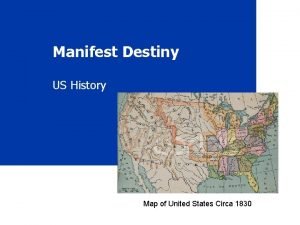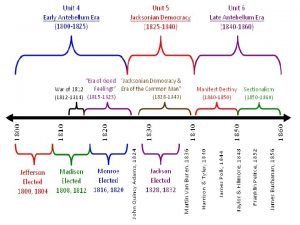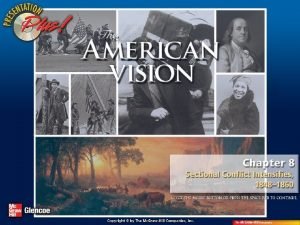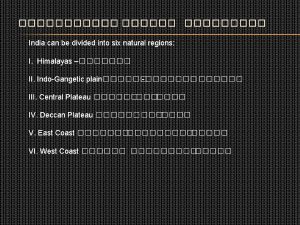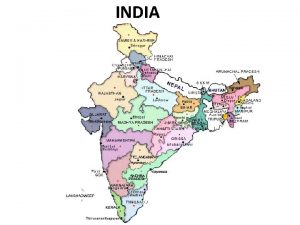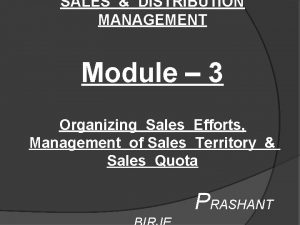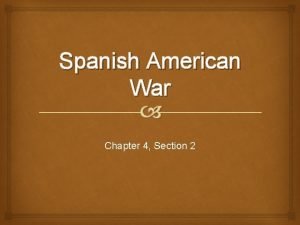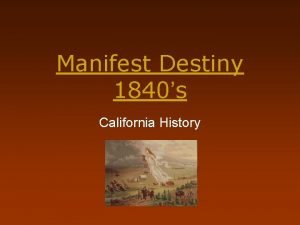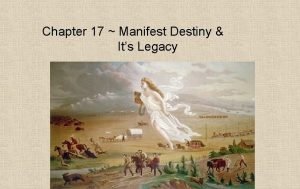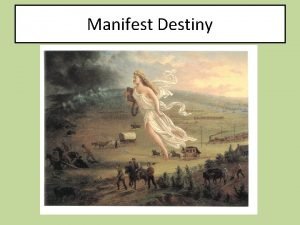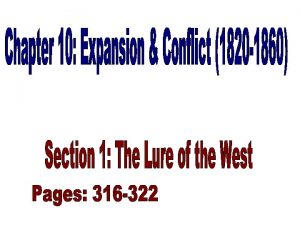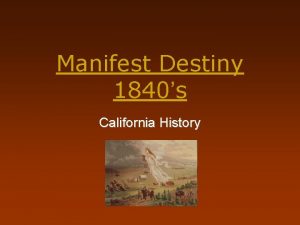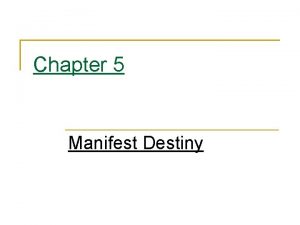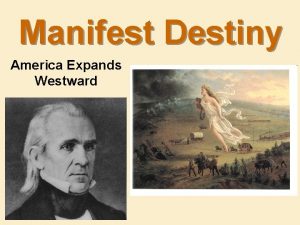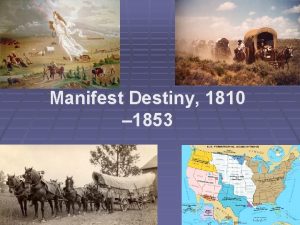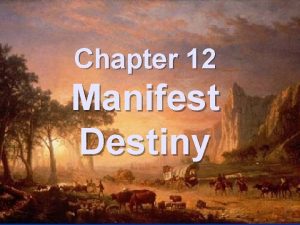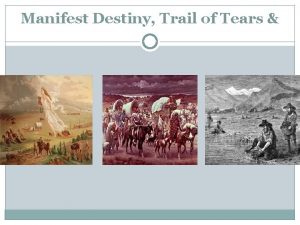Western Expansion Manifest Destiny Pg 6 7 Territories























































- Slides: 55

Western Expansion

Manifest Destiny Pg. 6 -7 Territories Gained & How pg. 3 -5 TUESDAY 9 -8 -15

Tuesday 9 -8 -15 Warm Up • Work on vocabulary on page 1 – Chisholm Trail Pg. 99 – Great Plains Pg. 99 – Homestead Act Pg. 104 – Interstate Commerce Act of 1887 Pg. 164 – Sodbuster Pg. 104 – Transcontinental RR Pg. 123


The Last American Frontier What is the frontier? The Frontier has generally been defined as the line separating areas of settlement from “unsettled” wilderness territory. From another point of view, the American frontier marked the dividing line between areas where Native Americans lived and areas settled by more technologically advanced people.

carefully at the picture. Circle 5 things that stand o Manifest Destiny Look Be ready to discuss why you circles them. Pg. 6 • What did you circle? Why? • What is happening in this picture? • Who is guiding them? • What do the light and dark places represent? John Gast, American Progress, 1872

Territorial Growth- pg 3 -5 • You will need to ID the following: – Name of the territory – How US gained territory – When US gained territory – What resources territory provided – What states were created from territory • Use pages 764 -765 to identify the territories. • Complete the chart “U. S. Growth 1776 -1853” on page 3 -5 in your booklet. You may use state abbreviations.


• The Settlement of the Frontier • Reasons why Americans moved west: 1. Gold!!-precious Metals such as gold & silver were being discovered in the mid 1800 s 2. Removal of Indians- Plains Indian Wars were devastating to tribes, but freeing up land for whites 3. Railroads- faster movement to the west & connection to “civilization” 4. Cheap land- legislation such as Homestead Act made farming & land owning more affordable 5. Cattle Industry- railroad growth = faster shipping of goods, increased demand in food such as beef 6. Farming- Great Plains full of fertile land, suitable for more than sustainable farming

Page 7 • Looking at your maps & using your knowledge of US History, what do you believe was the biggest reason why people were willing to take a major risk and relocate to the Great Plains? Explain your response in the space below in complete sentences.

• Warm up pg. 8 -9 create key on pgs 8 -9 • Mapping the West pgs. 8 -9 TUESDAY 9 -9 -15

In pencil, label each state with its official abbreviation: Also on Pg. 760 -761

Day 3: Mapping the West Page 89 • Step One: Title Your Map: Western Expansion • Step Two: Create a Key • ^^^^^^^ Mountains • ####### Railroads • ------ Rivers • -----Chisholm Trail • ------ Oregon Trail

Mountains ^^^^

Mississippi River

Great Plains http: //www. youtube. com/watch? v=p. QKwzh. EXLEo

First Transcontinental Railroad Click Image for Transcontinental RR Video 4 mins

Cattle Trails Pg. 99 Chisholm Trail 1 st major cattle route from San Antonio through Oklahoma to Kansas Click on me to find out about the trail,

Oregon Trail 1836 Many pioneers migrated West on the trail. *Click on image for Story of U. S. 3: 24

Physical geographic features of the Great Plains, pg 10 Factors Feature v Rural, Low Population Density relatively flat grasslands v Several rivers crossed west to east v v v Sparse Vegetation (only found along rivers) Effects Supported large herds of American Bison (buffalo), antelope, elk, and other animals (including predators) v v Allowed travel into and across the plains following the rivers (navigation) Source of water Required settlers to come up with alternatives for houses, such as the soddy and the dug-out v Good fertile farmland Allowed travel following the rivers; source of water Soddy houses —houses made of grass and mud

Physical geographic features of the Great Plains Image source http: //www. worldwildlife. org Image source http: // hauensteincenter. org Image source http: //memory. loc. gov/ammem/award 97/ndfahtml/images/hult_sod_02. jp g

Human & Economic geographic factors in settlement of the Great Plains, pg 11 � Railroads granted land on either side of their railroad lines to sell to farmers and ranchers – money raised builds the railroad – railroad gets customers (farmers and ranchers ship their goods east, new settlers and manufactured products move west) Mineral Rushes Gold strikes in California started the move west � Transcontinental railroad built to move gold and silver � Gold and silver in the Rocky Mountains brings more people west � All of them have to cross the Great Plains, some stay � Push or Pull?

Human & Economic geographic factors in settlement of the Great Plains, pg 11 • Poverty drives people west after the Civil War – Poor whites from both the north and the south – Former slaves from the south (Exodusters) � Free land with the Homestead Act – move west, find some land owned by the government, farm it for five years, and it becomes yours! Push or Pull?

Changing Demographics on the Great Plains, pg 12 Causes of demographic change… Poor Whites and freed African Americans move onto the Great Plains seeking new opportunities Farmers move west to take advantage of free or low cost land Immigrants come to build the railroads

Effects of demographic change, pg 12 American Indians pushed off land Population becomes more diversified (whites, African Americans, immigrants) Shift from hunter/gatherer lifestyle to domesticated farming/ranching and supporting towns

Closing the Frontier: pg 13 originally planned to bring California gold and Nevada silver to US East coast to pay for the Civil War Granted lands to sell in order to finance construction Farmers attracted to low cost land Transcontinenta l Railroad Image source: http: //upload. wikimedia. org/wikipedia/commons/e/e 4/1869 -Golden_Spike. jpg Allowed farm products to be shipped back east in order to feed a growing population Branch lines built to reach all areas of the frontier

Pg 16 Closing the Frontier: Homestead Act Five(5) year application process for free land q. File Application q. Live on land improve it (build a 12 x 14 dwelling) q. File for Deed of Title 160 acres to citizens who had not borne arms against the Union during the Civil War. By 1934, 1. 6 million applications processed 270 million acres of land (10% of the US) obtained by Homesteading

Note Completion: must complete notes, pgs 16 -17 • How did the Railroads and Homestead Act contribute to the closing of the frontier? • What was the economic impact of the Transcontinental Railroad on the frontier? • What was the economic impact of the Homestead Act on the frontier? • How did the growth of railroad allow for the growth of the cattle industry boom?

Farmer Game Uncertainties of Farming in the Gilded Age

Directions In your assigned groups: 1. 2. 3. 4. 5. You will be loaned $2000 You must set aside $200 (transportation) and $300 (living expenses) each round (year) You must decide which items to farm (crops/livestock) Assign a recorder to document items farmed Set a goal for how much money you hope to make

Farming Crops ($50) FARMING • The cost to plant crops is all the same. • You can grow up to 160 acres of crops (16 items). You may plant on all the land , or only part of it. • You will buy your crops from the Crops Market. SELLING CROPS • They may sell for different prices depending on the market. • You will learn what your investment return is after you turn in your crops to the market.

Raising Livestock ($5) RAISING You may decide to raise livestock. You only need to pay for the cost of feed. You do not need to reserve farm land for livestock. At this time, public land could be used for this purpose. SELLING LIVESTOCK • They may sell for different prices depending on the market. • You will learn what your investment return is after you turn in your crops to the market. • •

THE YEAR: 1885 PLANTING CROPS/RAISING LIVESTOCK

CROPS ($50) CORN BEANS WHEAT BARLEY OATS FIELD HAY TOBACCO FIELD PEAS LIVESTOCK ($5) [Maximum: 20 each] CATTLE SHEEP HOGS

A serious lack of early spring rain in July almost destroyed the wheat, barley, and oat crop in central Nebraska. The prices paid for corn, beans, field peas, and tobacco are up because of drought east of the Mississippi. Cattle prices are depressed because of large herds of range stock being sold in Texas. The price for sheep is up and the price paid for hogs is at an all time high.

Item 1885 Corn Beans Wheat Barley Oats Field Hay Tobacco Field Peas Cattle Sheep Hogs Investment Return $100 $150 $100 $100 $5 $10 $15

THE YEAR: 1886 PLANTING CROPS/RAISING LIVESTOCK

CROPS ($50) CORN BEANS WHEAT BARLEY OATS FIELD HAY TOBACCO FIELD PEAS LIVESTOCK ($5) [Maximum: 20 each] CATTLE SHEEP HOGS

THE YEAR: 1886 OUTCOMES

This was the coldest winter in history with temperatures of 60* below zero destroyed most of the cattle and hogs. Sheep prices are high. Abundant spring and summer rain throughout most of the state has produced excellent crops. The price of corn, wheat, barley, and oats is good and the price of tobacco and field peas remains the same. The bean crop has produced a small yield because of late frost and the field hay prices are depressed because of limited demand for hay.

Item 1886 Corn Beans Wheat Barley Oats Field Hay Tobacco Field Peas Cattle Sheep Hogs Investment Return $100 $50 $100 $25 $100 $0 $15 $0

THE YEAR: 1887 PLANTING CROPS/RAISING LIVESTOCK

CROPS ($50) CORN BEANS WHEAT BARLEY OATS FIELD HAY TOBACCO FIELD PEAS LIVESTOCK ($5) [Maximum: 20 each] CATTLE SHEEP HOGS

THE YEAR: 1887 OUTCOMES

Nature dealt a crushing blow to farmers in Nebraska. After a hot dry spring with little rain, a plague of grasshoppers infested the crops. Most crops are badly damaged. Cattle prices are very good, as the range herds have not yet recovered from the killing winter of ‘ 86. Sheep prices are depressed by hog prices are good.

Item 1887 Corn Beans Wheat Barley Oats Field Hay Tobacco Field Peas Cattle Sheep Hogs Investment Return $50 $0 $25 $75 $50 $100 $25 $50 $15 $5 $10

FARMING AFTER 3 YEARS OUTCOMES – Have you made a profit? !

Did you make a profit? 1. How much money did your “family” make? 2. Did your family make a lot of money? 3. Did your family make as much as you had hoped? 4. REMEMBER – you still have to pay back your $2000 loan. So, did you make a profit?

Assimilation of Natives pg. 17 Pg. 18 Into the West Video Pg. 19 Letter Home FRIDAY 9 -11 -15

Life of the Natives, pg 17 • Warm Up: • Get a book and find pg. 110, read Americanization and the Dawes Act. • Define the word assimilation in your own words after reading. Also add the term, Americanization, to your list of vocab and define that term in your own words.

Life of the Natives, pg 17 • Reliant on the buffalo • Nomadic lifestyle clashed with settlers land ownership • Religious practices viewed as “heathens” by whites • Overall style of dress & social structure viewed as uncivilized

Carlisle Indian Industrial School, pg 17 • Founded by a former Army officer who had served on the Great Plains • Tried to assimilate young Indians by putting them in a boarding school and teaching English and vocations Three boys before & after enrolling

Into the West, pg 18 • Watch the segment about the Native Children attending the school • Take notes on each of the following people Click on image for video. – George/Voices that Carrystudent at school – Capt. Pratt- creator of school – Daniel Wheeler- vocational teacher – Clara Wheeler- English teacher

Into the West, pg 19 • Following watching Into the West, you are to write a letter home as though you were one of the four main characters in the segment

Track Yourself • On back questions to answer: 1. What was your reaction to your test score? 2. What did you do to prepare for the exam? 3. What would you do differently next time? 4. What do you hope to make the next time?
 Jimmy fallon gadsden purchase
Jimmy fallon gadsden purchase Westward expansion territories map
Westward expansion territories map Chapter 17 manifest destiny and its legacy
Chapter 17 manifest destiny and its legacy Manifest destiny
Manifest destiny What did john l o'sullivan mean by manifest destiny
What did john l o'sullivan mean by manifest destiny Manifest destiny definition
Manifest destiny definition Five civilized tribes
Five civilized tribes Costs of manifest destiny
Costs of manifest destiny America is destined for better deeds
America is destined for better deeds Manifest destiny
Manifest destiny Manifest destiny
Manifest destiny Manifest destiny and the growing nation answer key
Manifest destiny and the growing nation answer key Rts manifest
Rts manifest Manifest destiny
Manifest destiny Manifest destiny
Manifest destiny Manifest destiny era
Manifest destiny era Chapter 12 manifest destiny
Chapter 12 manifest destiny Manifest destiny def
Manifest destiny def Hailstones
Hailstones Manifest destiny propaganda poster
Manifest destiny propaganda poster Manifest destiny who is the lady
Manifest destiny who is the lady Manifest destiny was used to justify an american desire to
Manifest destiny was used to justify an american desire to Manifest destiny
Manifest destiny How does this painting represent manifest destiny?
How does this painting represent manifest destiny? Facts about manifest destiny
Facts about manifest destiny United states map 1830
United states map 1830 Reasons for manifest destiny
Reasons for manifest destiny Manifest destiny 1840s
Manifest destiny 1840s Manifest
Manifest Manifest destiny effect
Manifest destiny effect Keyboard poem
Keyboard poem Manifest destiny book
Manifest destiny book Manifest destiny map
Manifest destiny map Rio grande river
Rio grande river Monroe doctrine and manifest destiny
Monroe doctrine and manifest destiny Define manifest destiny in your own words
Define manifest destiny in your own words Oregon fever apush
Oregon fever apush Growth of the united states to 1853
Growth of the united states to 1853 Westward expansion essential questions
Westward expansion essential questions Manifest destiny newspaper
Manifest destiny newspaper Mexican cession map
Mexican cession map Whats manifest destiny
Whats manifest destiny Walker tariff apush definition
Walker tariff apush definition Manifest destiny map with dates
Manifest destiny map with dates Manifest destiny texas
Manifest destiny texas Lesson 1 slavery and western expansion
Lesson 1 slavery and western expansion Pars fibrosa
Pars fibrosa Six natural regions of india on map
Six natural regions of india on map States and union territories
States and union territories Function of sales executive
Function of sales executive Breakdown method in sales
Breakdown method in sales Chromosome territories
Chromosome territories European colonization of americas
European colonization of americas Writing territories
Writing territories Writing territories examples
Writing territories examples Spanish american war territories
Spanish american war territories


